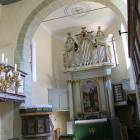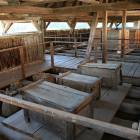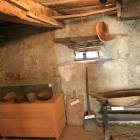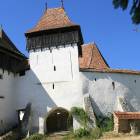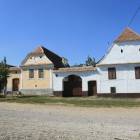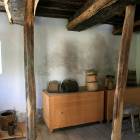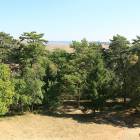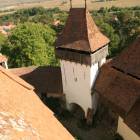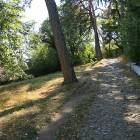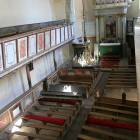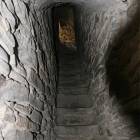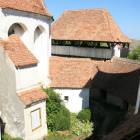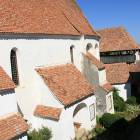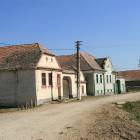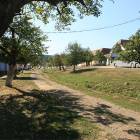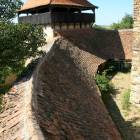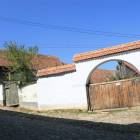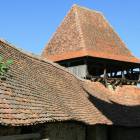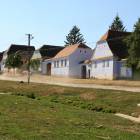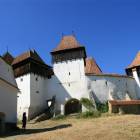Viscri: how does the place that has fascinated Prince Charles look like
An anonymous village in Transylvania has aroused the curiosity of European tourists in recent years, due to a famous royalty who decided to buy a vacation house here. Viscri is a small village, hidden inside an imaginary triangle of three cities in the center of Romania: Brașov, Sighișoara and Făgăraș. Brașov is one of the largest and most industrialized towns in the country, a historic city surrounded by peaks of Carpathian Mountains. Sighișoara is the oldest medieval citadel in Europe with uninterrupted social life, considerably smaller, but made famous by its architecture and its connection with the myth of Dracula. While Făgăraș is also an old town, with its own medieval fortress, also famous for its anticommunist armed resistance movement, carried for more than a decade in the harsh Făgăraș Mountains, the highest in the country.
But the Prince of Wales was not looking for such destinations, overwhelmed by tourists, for his holidays. Instead he chose a spot that was not even on the main road between Brașov and Sighișoara. To get to Viscri, you need to abandon European Road E60, that connects the two towns, and is in good shape, either in Rupea or in Bunești (8,4 km). Both these villages are the ends of a side road through the hills, that has Viscri somewhat in the middle. If you entered this road from Rupea, follow the signs for a right turn right before Dacia village, otherwise it’s impossible to get lost in the region as the road is not going anywhere else than back to the main European road.
The landscape is not really breathtaking as it often gets in the mountains of Romania, instead there are just mild hills and planes with meadows and orchards. And you realize what attracted Prince Charles here, as the green hills in the spring or the yellow fields in the autumn resemble a typical Scottish landscape. Either that, or the Saxon distant genealogy of the prince, who recently revealed that he is somewhat related with Vlad the Impaler, the historic ruler of Romanian County that inspired the literary character count Dracula.
You should know that this central region of Romania, part of Transylvania, is demographically distinct from the rest of the country by that it has an overwhelming Hungarian population. Hungarians, who make up some 5 percent of the general population of Romania, are concentrated mainly in a region inside the natural arch created by the chain of Carpathian Mountains. In its past, Transylvania was colonized by the Hungarian crown with Saxons (Germans) that created the most important towns, citadels and fortified churches of this region, and also with Szekelys (Hungarians), a group of settlers called to defend the region in the Middle Ages. The origins of this ethnic group are mysterious and is not clear whether they were Magyars at origin or were converted to this culture later on, but they are now very attached to their Hungarian (Magyar) identity, which they cultivate in language, tradition, food and arts. So when you visit Viscri as a foreign tourist, you may not get a taste of Romanian rural life, but rather feel like in Hungary. Also, Gipsies make up a large demographic in this village, where ethnic tensions or criminality problems have not been reported.
You should also be warned that the remoteness of this village not only helped it preserve its natural state, but also kept it bellow the poverty line of a typical Romanian village. While in many other places you can see new large villas being built or small businesses taking shape, here all houses are old and in the tradition of Hungarian and Saxon architecture, with large gates and high fences. Don’t be surprised to see cows, geese and harmless dogs lounging in the dusty unpaved main road of the village. The actual road to the village is asphalted but with lots of holes. The local authorities have been caught by surprise by the unexpected international fame of Viscri and have just started repaving this road, so chances are you will find it ready next time you come and visit.
The abundance of curious tourists has awaken an array of small business activities from the locals who are now sewing or cooking all sorts of souvenirs, jams and delicacies. Though genuinely local products, that help the locals get by, some are a little overpriced, so look around also in other cities to bargain for best priced souvenirs.
The main tourist attraction, besides the common looking mansion of Prince Charles is the fortified hill church. Fortified churches are as spectacular to visit as common in many villages and towns of Transylvania, this being only one of those included on UNESCO World Heritage list. This type of construction was typical for settlers of Saxon or Szekely origin, very distinct from the Orthodox fortified monasteries found in Bukovina, a neighboring region. Usually fortifications were a landmark of local nobility, but there are also cases of citadels built by peasants, as is the case in Viscri.
Different from other fortified churches in Transylvania, that employ the Gothic style, here settlers used an older Romanic church, that they modified in time and around which fortified walls, watchtowers and bastions were built. The materials were very basic, starting with mud, than improved with wood. Some towers were dwelt by the priest or by other officials like the mayor, who financed his own residence in such a tower. The place was also used for day to day activity and it even engulfed a cemetery. The small Evangelical church is revealing for the life of this united community, with its crafted stands for believers and chorus, with painted wood and modest decoration. It is still possible to climb in the highest tower to get a view of the surroundings. Also the walls have dark corridors with access to the place from where the archers would have aimed and some rooms contain objects used in daily life in traditional Hungarian and German communities.
Mai multe despre: Romania • Bodendorf • Brasov • Bunesti • Deutschweiskirch • fortified church • Great Britain • Magyars • Prince Charles • Romania • Szaszbuda • Szaszfeheregyhaza • Transylvania • Viscri • Weiskirich- Home Page
start page - Architecture
landmark buildings - Sacred architecture
places of worship - Nature
landscape photography - Concert
performing artists - Christmas
Santa Claus pictures
- Jooble
jobs for photographers - Escape
an out of control blog - Merry Christmas
The best organizer of Christmas parties - Astro photo
Eclipse hunting and astrological photography

